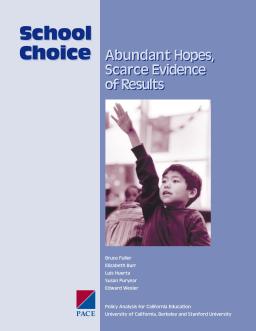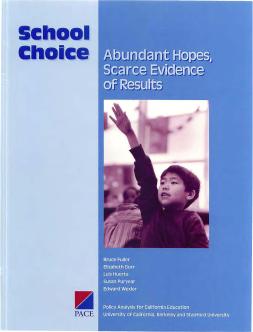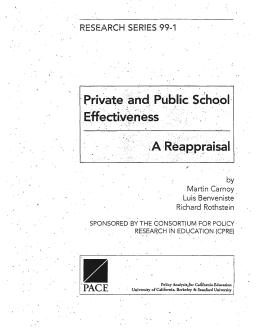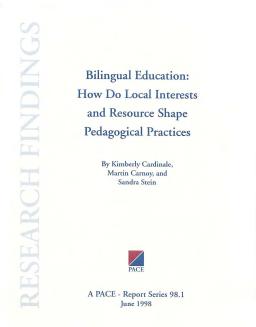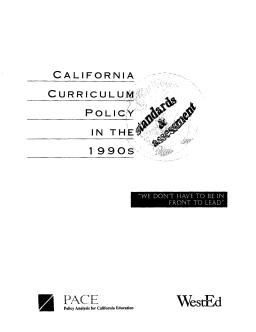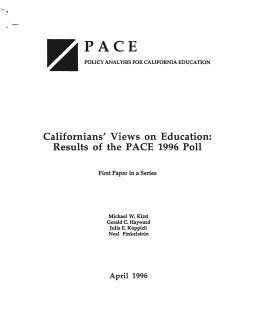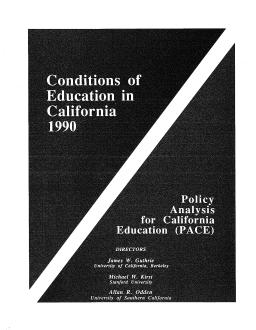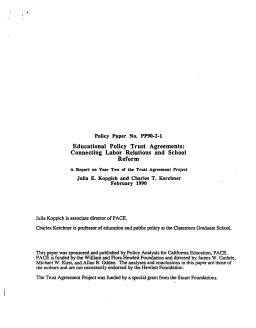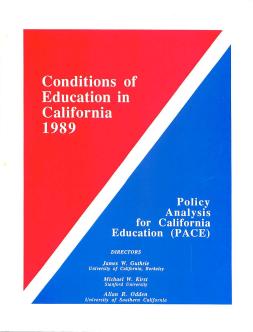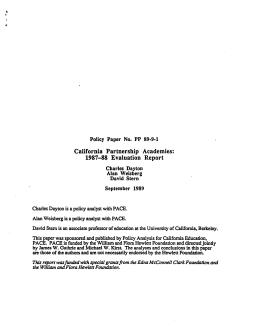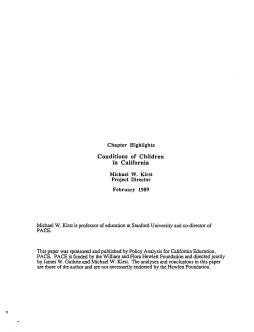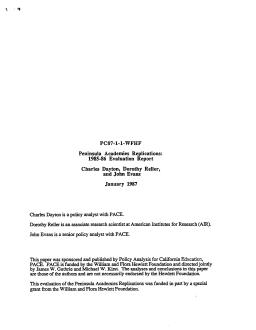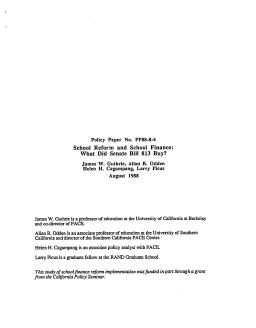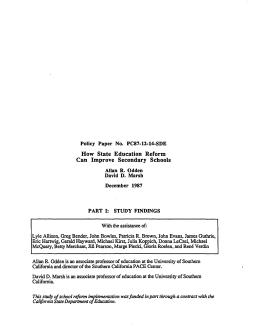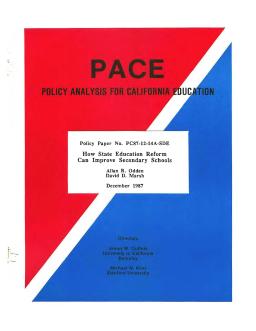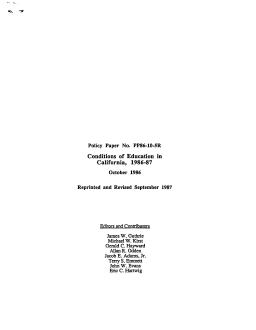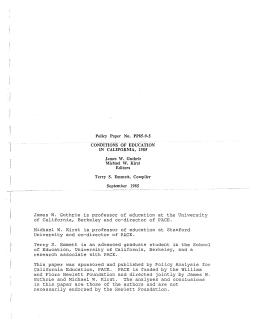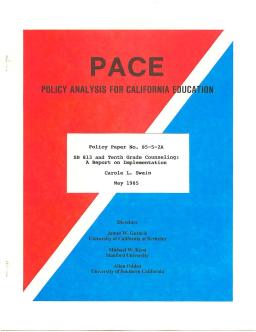Abundant Hopes, Scarce Evidence of Results—Executive Summary
Published
Summary
Public education in the US is widely criticized and everyone wants to reform it, but there's no consensus on the best strategy for improvement. This report focuses on school choice, a reform avenue gaining steam in California and the US, to explore policies and institutional changes that can boost children's learning.
Abundant Hopes, Scarce Evidence of Results
Published
Summary
Public education receives criticism from various stakeholders. Despite satisfaction with local elementary schools, overall quality concerns prevail. There is no consensus on the best approach to improve schools. PACE report investigates school choice, which is a reform strategy gaining popularity in California and beyond.
A Reappraisal
Published
Summary
This report challenges the belief that public schools are ineffective due to a lack of accountability for producing high academic achievement. Some argue that private management is necessary for improvement, but this report seeks to analyze the range of responses that schools have to accountability and determine whether market forces are necessary for improvement.
How Do Local Interests and Resources Shape Pedagogical Practices?
Published
Summary
Bilingual education implementation varies by district due to discourse and policies. Four issues affecting implementation are teacher recruitment, "ghettoization" of bilingual education, race relations, and community consensus. National debates impact local administrative actions, defining bilingual education practice. The report analyzed four California school districts to show the impact of these four issues on program design.
California Families Face Gaps in Preschool and Child Care Availability
Published
Summary
This report highlights the unequal distribution of preschool and childcare opportunities in California. Despite spending $1.2 billion annually, half of preschool-age children live in households with working mothers, with enrollment dependent on income and location. Counties vary greatly in their supply, with affluent parents more likely to find preschool or childcare slots. Latino children are hit hardest, even in counties with ample supply, with supply in predominantly Latino areas half that of low-income Black or Anglo communities.
Standards and Assessments
Published
Summary
This study traces California's curriculum-related reforms in mathematics and science during the 1990s, examining the role of the California Department of Education and the state's shifting political and policy context. It analyzes the perceptions of state officials, experts, and the public and how they influenced state policy changes. The authors raise questions about problems associated with curriculum policy in California and presents policy recommendations mentioned during interviews and document analysis. The study does not assess the impact of curriculum on school practice.
Results of the PACE 1996 Poll
Published
Summary
A 1996 statewide poll by PACE surveyed Californians on their views and expectations for public schools, informing policy discussions. Results revealed four broad themes and their relevance to ongoing education policy discussions, such as redesigning statewide assessments, reforming traditional school governance, providing public funds for private schools, and complex issues of local control. PACE believes public perceptions should be considered in policy discussions, although education policy should not be solely based on public opinion polls.
Published
Summary
This is the ninth edition of Conditions of Education in California. In this volume, PACE has compiled information on current critical issues in state education policy and presented them within the context of major policy developments. "Evolving Context" introduces the current issues in the state and sets the stage for the remaining chapters, which are Assessment and Achievement, Finance, Teachers and Teaching, Integrated Children's Services, Child Care and Development Services, and School-to-Work.
Published
Summary
The seventh edition of Conditions of Education in California by PACE focuses on education policy issues in a national context. The report analyzes California's education data by placing it in multi-state, national, and international contexts. The report's first three chapters analyze evolving education policy issues, Sacramento political dynamics, and student achievement. The remaining three chapters provide longitudinal data on student enrollment, finance, and system characteristics. The report aims to provide a continuing picture of education in California.
Published
Summary
CA's education system is affected by external factors like shifting demographics, declining economics, and intensifying politics, limiting the traditional routes of local decision-making and property taxation. Although some districts show excellence and commitment, creating and sustaining a statewide education system to meet 21st-century expectations is difficult without a comprehensive reform plan. Political conflict over revenue earmarking and school reform distracts from education improvement. This report describes and analyzes these issues, suggesting a comprehensive set of solutions.
Connecting Labor Relations and School Reform: A Report on Year Two of the Trust Agreement Project
Published
Summary
The Trust Agreement Project, initiated in September 1987, is a joint effort of 12 California school districts and their teachers' unions. It enables teachers and school management to develop agreements on professional issues beyond the traditional scope of collective bargaining. The agreements cover topics like teacher evaluation and curriculum development, and aim to enhance educational capacity by promoting collective responsibility for educational processes and outcomes. The project appears to be altering decision-making processes and encouraging collaboration between unions and management.
Published
Summary
This is the fifth edition of Conditions of Education in California. Over time, the content and format have changed in keeping with suggestions made by readers. This publication is based upon compilations and syntheses of information collected by other agencies and individuals. These sources are noted throughout the text. We wish here to express our appreciation to these others upon whose efforts we depend so heavily. Also, PACE undertakes a substantial amount of original data collection and analysis. We make specific mention of this throughout the text.
1987–88 Evaluation Report
Published
Summary
This report presents findings from the third annual evaluation of Partnership Academy Programs in CA, a high school-based, state-funded program with a school-within-a-school administrative structure that enrolls at-risk students with academic potential. The program provides students with basic job skills in a promising labor-market field and support from local businesses, including curriculum development, guest speakers, field trips, mentors, and work experience positions. The evaluation addresses the quality of program implementation and the degree to which programs follow the academy model.
Chapter Highlights
Published
Summary
This report provides social indicators to evaluate the quality of life for children in California, covering physical and mental health, safety, sexual behavior, academic achievement, and the settings and systems that serve children. Despite most children being healthier and better schooled than in the past, recent polls indicate concern about child-rearing and the likelihood of an expanding educational underclass. The report aims to offer a portrait of the quality of California's children, address gaps in available data, and provide limited policy recommendations.
1986–87 Evaluation Report
Published
Summary
In the fall of 1985, ten academy programs were established by the State of California as replications of the Peninsula Academies. PACE evaluated these 10 academies in 1985–86. This report presents findings from a second evaluation covering the academies' 1986–87 school year.
Published
Summary
The fourth edition of Conditions of Education in California has expanded its content to include a special features section on education reform processes, along with the previously included sections. The publication is based on compiled information from other sources and original data collection and analysis. The format has been altered to improve readability for a wide range of audiences.
Study Findings
Published
Summary
In 1983, California's Senate Bill 813 aimed to improve the education system by proposing a large number of reforms. However, it lacked a cohesive strategy and proven philosophy. The bill's impact on school districts and schools was unknown, and this study aimed to assess whether selected schools could implement the reform components and whether they contributed to school improvement. The goal was to understand how schools reacted to state mandates and inducements for improvement.
Background and Technical Appendices
Published
Summary
California's education system faced a decline in the early 1980s, prompting reforms such as a common core curriculum, higher graduation requirements, and tougher academic standards. A Nation at Risk report further pushed for nationwide school changes. California's swift response led to the enactment of Senate Bill 813, a comprehensive education reform program with over 80 policy and program reforms. Several studies showed positive results, but the study in this report aims to determine how state-level education reforms improved local schools.
Published
Summary
Continuing growth and sustained progress on educational reform characterize California's public schools, but the Gann spending limit, which potentially restricts state dollars for education, and projected shortages of highly qualified teachers dampen prospects for continued educational improvements. Indications of important educational progress in California, which PACE documented in Conditions of Education in California, 1985, continue on many fronts. This is particularly true when compared to the recent decade of serious decline in California's public school system.
Published
Summary
This technical report provides an overview of California's educational system, intended for educators, public officials, journalists, and informed citizens. With over four million students and a $17 billion annual cost, the state's school system is vast and complex. The report offers comparisons of California's education system to itself in prior years and other states, revealing patterns of change and suggesting future trends. These trends serve as a guide for the many facts and figures presented in the report.
1982–83 to 1984–85
Published
Summary
This study examines curricular changes in California high schools from 1982-85, as educational reforms aimed to enhance academic rigor. Findings show increased offerings in academic subjects like math, science, and advanced placement, and decreased offerings in areas such as industrial arts, home economics, and business education. The data aligns with statewide curricular changes, likely influenced by mandates for more extensive graduation requirements and alterations to university entrance requirements.
A Report on Implementation
Published
Summary
Comprehensive school guidance programs attempt to address a range of student needs on personal, social, career, and academic dimensions. Many guidance and counseling programs, however, have suffered cutbacks in recent years even though students continue to be in need of guidance, and students themselves have expressed a desire for assistance.
Published
Summary
The first in a series of annual reports on education in California aims to assess school performance objectively. It summarizes data on demography, academic performance, curriculum, personnel, and finances. Highlighting California's 1983 education reform effort, the report provides a baseline for assessing future reforms, with successive reports addressing the same dimensions. It focuses on K-12 public schools but also includes some data on nonpublic and postsecondary education.
